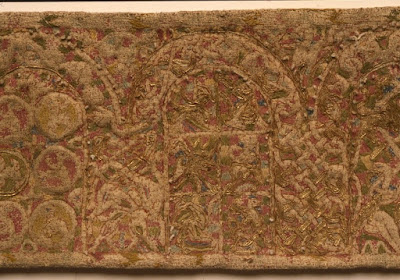The devotion of the Saints Harlindis and Relindis:
processions in Maaseik
by Katrien Houbey, Art Historian
The story
about Harlindis and Relindis dates back to the end of the seventh and the
beginning of the eight century. The first source mentioning their lives
probably dates from the second half of the ninth century. The devotion of the
two sisters from Aldeneik was first written down in the so called ‘vita’. It mentions that Franco, the
bishop of Liège, placed the relics of Harlindis and Relindis behind the alter
of Our Lady. From that moment on they have been devoted. However, written
sources about their devotion are very rare.
From 1202,
the annual procession (‘bankruisprocessie’) through the parish was held during
the days of Pentecost. This procession (‘cruces
banales’) was some kind of an obliged tax pay system ‘in procession’ of the
dependent parishes to a bishop or an abbey.
From the
eleventh century, relic expositions took place as well, after the example of
Maastricht, Aachen, Susteren and other cities. Later, in the fourteenth
century, Aldeneik joined the tradition of the processions being held every
seven years in Maastricht. Aldeneik was generally considered as a staging point
for pilgrims on their way to Maastricht.
This
tradition remained in use until 1566. The organisation stopped during the
Protestant Reformation when Calvinists caused many robberies and restless times
in the area. At that time, the canons decided to secure their belongings and
moved to Maaseik.
In the
period after 1571 the devotion of Harlindis and Relindis completely disappeared.
After the shrine had been opened on 22 March 1595, the seven-annual processions
were launched from 1601. This time, the events connected to the processions in Aachen.
The French
Revolution at the end of the eighteenth century caused new problems. All the
belongings of the church were confiscated and every form of devotion was
suppressed. Luckily, all of the objects related to the devotion of Harlindis
and Relindis were rescued from the French ruler.
The
devotion of the two saints did not revive until 1841, when the Codex Eyckensis
returned to the Saint-Catherine church. An official opening of the two shrines
of Harlindis and Relindis took place in 1867. In 1871, 300 years after the
canons had moved from Aldeneik to Maaseik, the time was right to commemorate
that movement. The ecclesiastical government decided to organise the
festivities every 25 years in honour of this event (‘translatio’).
On 1 May
1871, the relics were brought in procession to the church of Aldeneik. Under
the supervision of Bishop Theodore de Montpellier, the relics were exhibited
for 10 days and adored by the faithful. On this occasion, E.H. Emile Schoolmeesters
wrote a publication about the lives of Harlindis and Relindis.
The
procession as we know it today consists of different groups who depict
different scenes taken from the lives of Harlindis and Relindis. It was first
performed in 1897. Thirteen groups walked together in the procession on the
fifth and the twelfth of September.
The
procession of 1922 is the first event that has been well documented. Bernard
Claessens made beautiful sketches in colour of all the costumes, worn by all
the participants. A complete series of twelve folios of these designs are kept
in the archive of the Saint Catherine church. Nine groups of people
participated in the procession from Maaseik to Aldeneik and back.
Drawing procession 1922 (Archive of the Saint-Catherine Church Maaseik)
In 1947 a
similar procession was designed by the local artist Pieter Brouns. His
historical procession was organised in the streets of Maaseik and Aldeneik on
24 and 31 August. It was the first time that inhabitants from different town
districts collaborated to materialize the procession and participate in it. Several
choirs added to the atmosphere with live chants. On the market square, people
could attend a folk concert and enjoy a stage performance.
Cover for the procession of 1947 (Isabelle Brouns)
The 1972
procession was completely different. It was less historical and less religious
than the previous editions. The modern twist was given by the local artist Jan
Peeters. He focussed on the human being as an individual throughout the
centuries as a central theme. The modern approach was also reflected in the
fashionable designs and costumes. Jan Peeters had a second chance to design the
procession in 1997. He decided to
maintain the modern interpretation of the ancient tradition of the devotion of
the two Holy Saints of Aldeneik.
Procession 1972 (Documentation center Maaseik)
Procession 1997 (Mathieu Coenen)
Whether
this new trend will continue in 2022 remains to be seen. The preparations for
this future event have already started.












